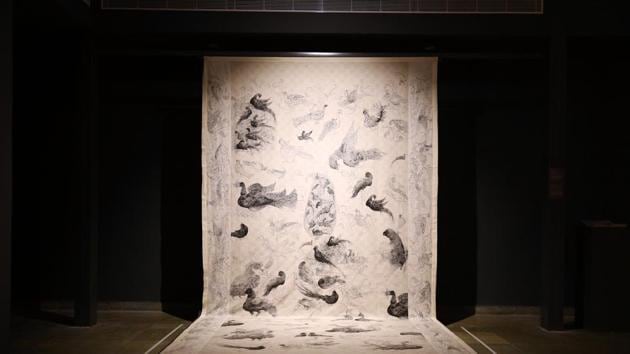Textile exhibition: Remembering the life and times of Martand Singh
A year after the death of Martand Singh, an exhibition celebrates the legacy of the extraordinary man who breathed new life into Indian textiles
When Martand Singh visited drought-hit Rajasthan in the ’70s on his mentor, Pupul Jayakar’s suggestion, he tried to find ways to re-employ and re-energise the artisans and weavers who had been struck the hardest. That visit changed him. This change would, in effect, shape the journey of Indian textiles in the decades to come. Singh is widely considered as the extraordinary man behind the revival of Indian textiles. To many though, he was more than just the function of his work – brilliant yet humble, modern yet spiritual. A year on from his death, an exhibition titled A Search in Five Directions pays homage to the legacy of ‘Mapu’, as he was affectionately known.

Five Directions refers to Singh’s own personal journeys along the different arms of the Indian textile industry. “It was a challenge, what to do, and what direction to take the industry in. Direction here technically means one of pigment-painting, hand-painting, resist-dyeing, block-printing and weaving, each of which Mapu tried to steer in his own way and through his exhibitions,” says Rakesh Thakore, one of the curators of the exhibition and co-founder of the design label Abraham&Thakore.
Singh was born in royalty, son of Sita Devi, the Maharani of Kapurthala. His education at Doon School in Dehradun and in St Stephen’s in Delhi reflected that privilege. But as many close to him know, he applied his knowledge of the finer things to momentous effect. “Mapu’s experience of living around the finest only helped create some of it at the weaver centres,” says Rta Kapur Chishti, textile historian and co-curator of the exhibition.
After he left college, Singh opened a boutique in the Oberoi hotel in Delhi, designing couture like leather pants and capes. But he soon left the establishment (amusingly called Psychadelhi) to join leading cultural activist Jayakar, who was cultural adviser to two Prime Ministers – Indira Gandhi and Rajiv Gandhi. He briefly headed the Calico Museum in Ahmedabad before coming to Delhi. “Ms Jayakar had set up the Weavers Service Centres through the ’50s. What Mapu did was to travel extensively, discover and talk to every person he met. That was one of his most stunning qualities, the ability to feel at home at every place and with everyone. He could sit at the big-boy table and blend equally well with weavers,” Chishti says.

Singh’s moment and that of the textile industry, came with the Vishwakarma exhibitions that were held as part of the Festivals of India between 1981 and 1992. They carried India’s textile heritage and history to the world. Thakore, who worked with Singh on the seven exhibitions, considers them a turning point in the history of textiles. “I think a lot of people within India and outside had never quite seen anything like it. It gave the world an idea of the heritage our country had,” he says.
But perhaps the more crucial impact the exhibitions had was on the weavers and artisans back home. “The festivals brought in work for the weavers and the centres. Mapu always wanted them to prosper, to be recognised. And the exhibitions achieved that,” he adds. As if confirming the faith that Singh put in India’s weavers, Thakore’s own label has continued to work with the weaver families the two had come in contact with during the exhibitions.
A Search in Five Directions has been drawn from the Vishwakarma exhibitions and is an eloquent expression of the sheer range and beauty of India’s textiles. Whether it is the Pethapur fabric of Gujarat or Gyasar from Varanasi, the impossible detailing and a sensationally seductive palette makes one realise – textiles are art. It is incredible that a tradition so rich was struggling and needed a revivalist in the form of Singh. “Trade routes to Africa and Central Asia had collapsed during colonial rule. A large part of what Mapu did was to decolonise the working and thinking of the Indian market. His knowledge of textiles and aesthetic helped in producing what had not been produced for years because mill-made fabrics had completely taken over the work of the weavers. Heritage was restricted to the museums. Mapu found a way of working with heritage outside the museums, right at the weaver’s doorstep,” says Chishti.
Apart from envisioning and guiding the production of textiles across India, Singh was also a staunch conservationist. His documentation of textiles and their history is remarkable. He, along with Jayakar, founded the Indian National Trust for Art and Heritage (INTACH) which continues to champion the conservation of art and heritage in India.
But what made ‘Mapu’ such a rarity? “He was one of the finest people anyone could work with. His ability to encourage people and share his knowledge, whether it was a student or a friend, was an extraordinary gift,” says Thakore. Now that he is gone, how can Indian textiles continue on the path set by him? “There’s been a revival of interest in the last few years because the fashion industry itself has got tired of producing western-styled clothes. But we can’t save textiles as long as weavers and artisans don’t get work or aren’t given the value they deserve,” says Chisti.
WHAT: Textile exhibition A Search in Five Directions
WHEN: Between 10am- 5pm (Monday closed), till March 31, 2018
WHERE: Crafts Museum, Pragati Maidan, Bhairon Marg.
NEAREST METRO STATION: Pragati Maidan.
CALL: 011- 2337 1887





